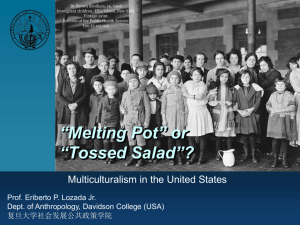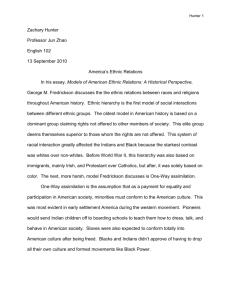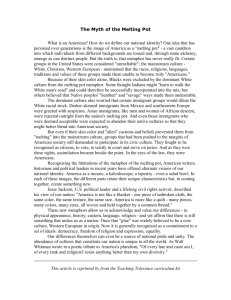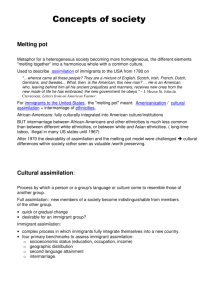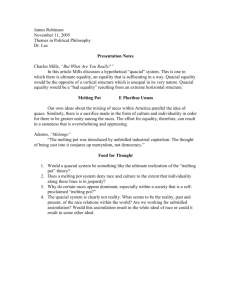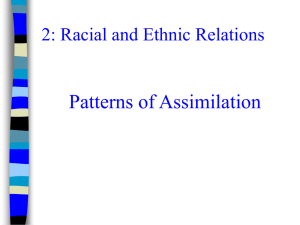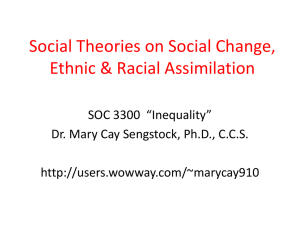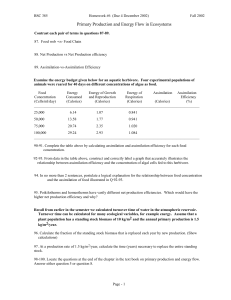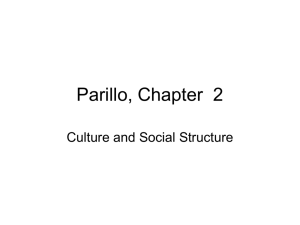Assimilation, Pluralism, & the Persistence of Ethnic Cultures
advertisement
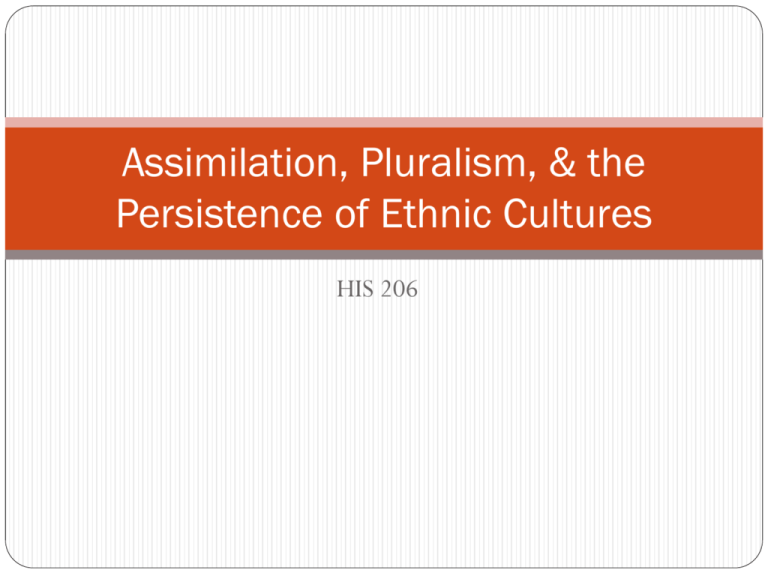
Assimilation, Pluralism, & the Persistence of Ethnic Cultures HIS 206 The Dominant, White, Anglo-Saxon, Protestant Culture Founding Fathers emphasized liberal ideology rather than ethnicity as basis of American national identity Needed to distinguish themselves from British Needed support of recent immigrants for Revolution 3 key elements: universal (though racially limited in practice), new, & future-oriented Immigrants seen as threat when assumed to be unable to assimilate to U.S. ideals Radicalism – Jacobins, Socialists, Communists, Anarchists, Terrorists, etc. Religion – Catholics, Jews, Muslims, etc. Race – Asians, Africans, etc. Assimilation or Pluralism? “Melting Pot” concept expressed cosmopolitan nationalism in keeping with universal ideology Assumed assimilation, but permitted retention of ethnic culture Occasionally backed by argument that mixed strains better than pure breeds Israel Zangwill Alternatives based on romantic nationalism Assumed group ties were primordial; therefore, assimilation was impossible and/or undesirable Nativism based on xenophobia and “scientific” racism & eugenics Horace Kallen advocated cultural pluralism Horace Kallen Americanization 3 phases of Americanization movement: Pre-World War I World War I Post-World War I 2 strains: Anti-German Sentiment During WWI Nervously nationalistic – D.A.R., National Civic League Positively paternalistic – settlement houses, Social Gospel World War I (1914-1918) shocked native-born with signs of immigrants’ lingering loyalties Led to intensification of efforts (inc. fed. gov’t) to achieve “100 Percent Americanism” Post-WWI intensity continued, fueled by Red Scare Chicago School (1920s) Robert Park, Ernest Burgess, William Thomas et al based their work on German conflict theorists Peasant societies & families had become disorganized by Robert E. Park industrialization, leading to personal demoralization In U.S., immigrants reorganized ethnic group parishes & mutual aid societies, ironically hastening assimilation Race relations cycle: contact, competition, accommodation, assimilation Marcus Hansen’s Law suggested interest in ethnic identity often re-emerged in 3rd generation Oscar Handlin’s The Uprooted (1951) described immigrants as dislocated peasants bewildered by modern industrial life Oscar Handlin Critiquing American Ideology 1940s-50s saw upsurge of interest in American ideology in reaction to Nazi & Soviet regimes Gunnar Myrdal’s The American Dilemma (1944) described gap between American ideal of equality & reality of minority treatment Ruby Jo Reeves Kennedy & Will Herberg suggested “triple melting pot” – Protestant, Catholic, Jewish John Higham’s Strangers in the Land (1955) argued nativism ran in cycles, and melting pot partially worked Bruising civil rights struggle created intense disillusionment “Black Power” movement embraced separatist black nationalist ideology & goals, spawning similar movements among other minorities White, working-class ethnics resented “special treatment” of minorities & asserted their own separate identities Gunnar Myrdal Assimilation Attacked New Ethnicity scholars saw American ideology as a sham rather than as an unfulfilled ideal Milton Gordon’s Assimilation in American Life (1964) argued structural assimilation would eventually take place, but for now U.S. divided into “ethclasses” Nathan Glazer & Daniel Moynihan’s Beyond the Melting Pot (1963) said melting pot never happened beyond core group Michael Novak’s The Rise of the Unmeltable Ethnics (1972) attacked WASP culture & described PIGS as subservient, but sullen & resentful New Social History also denied or minimized assimilation Herbert Gutman’s Work, Culture & Society in Industrializing America (1976) argued immigrants brought pre-modern work habits & created diverse ethnic subcultures John Bodnar’s The Transplanted (1986) argued immigrants created “culture of everyday life” in response to industrialization Recent Approaches Recent scholars have emphasized cultural construction of ethnicity, grounded in real-life experiences Werner Sollor’s The Invention of Ethnicity (1989) Kathleen Conzen et al’s article (1992) Labor historians describe inter-ethnic assimilation through labor unions Gary Gerstle, Working-Class Americanism (1989) James Barrett, “Americanization from the Werner Sollors Bottom Up” (1992) Whiteness Studies focuses on creation of white (Euro-American) identity David Roediger, The Wages of Whiteness (1991) Matthew Frye Jacobsen, Whiteness of a Different Color (1998) Kathleen Conzen Return to the Melting Pot American national identity based on a commitment to shared political ideals that transcends ethnic boundaries, despite racial boundaries of the past Melting pot ideal rejects assimilation v. cultural pluralism as false dichotomy Lawrence Fuch’s American Kaleidoscope (1990) describes voluntary pluralism – can embrace ethnic group identity & Americans civic ideals simultaneously Herbert Gans argues for “symbolic ethnicity” - most people still feel need for ethnic identity, but express it in voluntary, individualistic & intermittent ways Racial minorities have strongest identities experienced the most hostility Have the hardest time blending in due to physical distinctives
